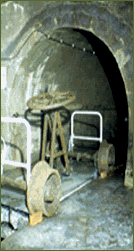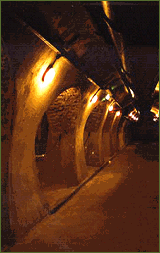|
Philippe Auguste, who was the king of France from the year 1180
right through to 1223, gave orders for the streets of Paris to be paved and have drains
put in, and so, Paris has had some form of sewers and draining wastewater since the 13th
century.
In around 1370 the first stone walled sewer was built in Rue Montmartre and this sewer was
to collect the wastewater and take it to a brook, rather than ending up back in the same
place on the River Seine.
The first covered sewers were introduced during the reign of Napoleon Bonaparte, with a
network of approximately 30km of vaulted tunnels built beneath the city of Paris. But then in the year 1850, Eugene
Belgrand, an engineer, designed the present day sewer system along with Baron Haussmann,
who developed a way of separating the drinking water and the wastewater.
This was a double system that was devised, where it would carry drinking water into the
city on one network and another network of tunnels would carry out the wastewater, which
was discharged far down stream from the city, so as to avoid pollution.
By the year 1878 this network covered over 600km and each street had its very own sewer,
which worked on gravity where it could, rather than using pumping stations.
The network today is more than 2,100km of sewer tunnels, which was begun in the year 1850,
although some things over the years have improved and been added.
The sewers do actually follow the streets that are above and whilst you are in the museum
you will be able to see numbers on each down spout, which corresponds with the house above
it.
Yet this is far from the only network below Paris today, as there are tunnels used for
amenities such as gas and electricity and the telephone network as well. But there
are also other tunnels beneath the city known as the Catacombes,
which are home to lots of bones from burials.
But lets look at Le Musee des Egouts de Paris, otherwise known as the Paris Sewer Museum,
which as it quite rightly says, is dedicated to the sewer system of Paris, France.
You will get to learn about Aubriot, who was the designer of the first vaulted sewer,
Eugene Belgrand, who was the engineer that was responsible for the current sewer network
along with Baron Haussmann, who developed a way of separating the drinking water and the
wastewater.
There are exhibits on display in the Eugene Belgrand Gallery with the machinery used both
in the past and the present and from the floor you can see down to the bosquet sand
trap. Other galleries present the water cycle and the jobs of the Paris sewer
workers along with a journey 500m right into the sewers.
Initially tourists used to be carried through the sewer tunnels by carts, then by
carriages drawn by a locomotive, then by boats, but these have all gone since the
introduction of the Musee des Egouts de Paris, which is located on the Left Bank under
Quai d'Orsay.
This museum will provide a fascinating look at history from a completely different
perspective along with the marvels of engineering and how Paris has dealt with everyday
aspects of life through the centuries, that today we take for granted.
And with over 2km of galleries, the Musee des Egouts de Paris shows an exhibition of the
water system. This includes its purification systems along with displays of machines
and models, which illustrate techniques that have been used through the ages and how man
power has also evolved for the maintenance of the very essential water cycle.
The tour, which lasts approximately just over an hour starts with a film, continues with
historical photos and displays and ends with a walk through the maze of tunnels, guided by
a sewer worker. And there is even a gift shop at the end.
Although the very idea of visiting the sewers of a major city could send shivers through
some and may not be very appealing to others, it is definitely an unusual tourist
attraction and a first in terms of its originality and historical value.
So if you would like to see Paris as you would never
have imagined it, yet are willing to put up with a little bit of a smell, then it is well
worth a visit and lets face it, you will amaze your friends when you tell them where you
have been! and seen!
The Musee des Egouts de Paris is open every day except Thursdays and Fridays. During
the summer months it opens from 11am through to 5pm, but in the winter months it closes at
4pm.
The museum is also shut during holidays and for approximately 3 weeks every January, so it
would be advisable to check on the times before you arrive for your sub-Paris adventure.
The museum entrance is a ticket booth on ground level on the Left Bank of the River Seine
between the river and the Quai d'Orsay in the 7th
arrondissement of Paris.
Address & Contact Details:
Musee des Egouts de Paris
Face 93, Quai d'Orsay
75007
Paris
Telephone: 1 53 68 27 81
|
|



